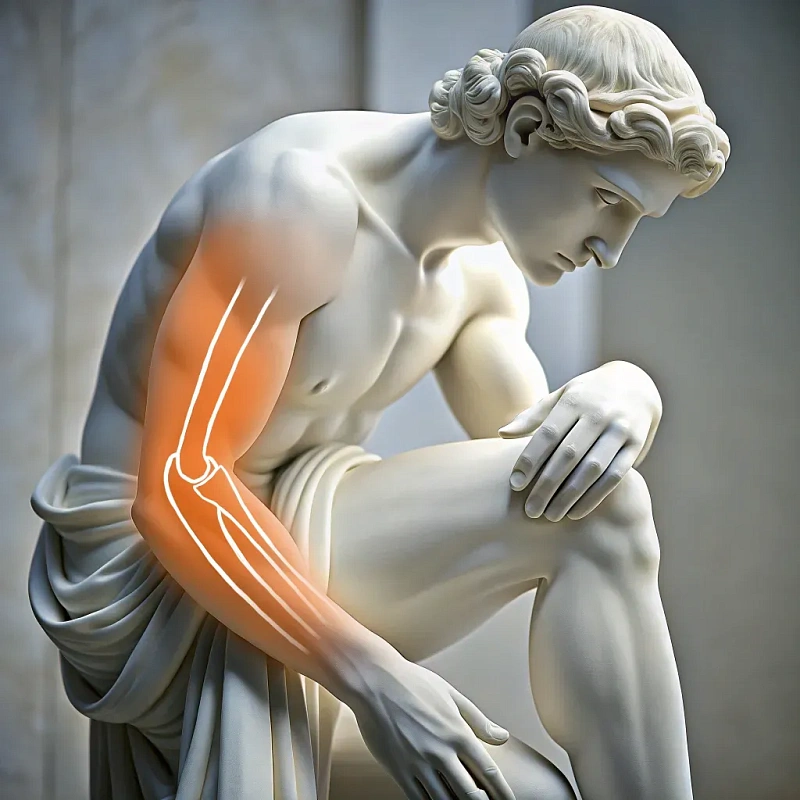Treatment of peri-implant fractures
Peri-implant fractures are bone fractures that occur around orthopaedic implants: artificial joints or metal pins. The fractures can be caused by trauma, weakening of the bone around the implant or deterioration of the implant itself.

Peri-implant fractures can occur around implants as a result of falls, car accidents, osteoporosis or overload. These fractures can be complicated because of the implant, which changes the normal load distribution in the bone and complicates treatment.
Major symptoms of these fractures include acute pain, swelling, deformity and restriction of movement in the injured area. Immediate medical attention is critical for accurate diagnosis and the best treatment plan. Treatment of peri-implant fractures depends on the nature and extent of the injury, as well as the condition of the implant and surrounding tissues. Nonsurgical treatment is possible in some cases, but most require surgical intervention to ensure stability and proper bone fusion.
Common blood and urine tests. Coagulogram for blood clotting assessment. X-ray, CT or MRI to study the fracture and the condition of the implant. Consultation with an anesthesiologist to choose the best anesthetic option. Physician's examination for general assessment of the patient's health.
Simple, non-displaced fractures are treated conservatively by immobilizing the affected area with splints or plaster casts to promote healing. Surgical intervention may be required when conservative treatment is ineffective or in case of complex fractures. Prior to surgery, the implant is evaluated to determine if it needs to be replaced or corrected. Next, open reduction is performed to restore the correct position of the bone fragments and their securing with steel plates, screws, pins or external fixators. Complex cases may require soft tissue reconstruction or implant replacement.
X-ray, CT or MRI equipment for intraoperative monitoring. Metal fixators (plates, screws, rods) for stabilization of bone fragments.
Following treatment, patients begin the rehabilitation phase, which includes physiotherapy and exercise therapy to restore strength and mobility to the limb. Rehabilitation can take a long time and requires regular medical supervision to assess the healing progress and implant function. The duration and intensity of rehabilitation is based on the extent of fracture and the patient's general health.
Benefits
Restoring bone integrity
Fusion of bone fragments to restore correct anatomy and limb function.
Preserving implant function
Stabilization and optional implant replacement to maintain its functionality.
Preventing complications
Reducing the risk of infections, further weakening of the bone and mobility loss.
Frequently Asked Questions
When is surgical intervention required for a peri-implant fracture?
How long does rehabilitation take after a peri-implant fracture?
What complications can occur in peri-implant fractures?
Didn't find an answer to your question?
You can describe your problem in detail and ask a question to the doctor. He will answer you and help you find a solution
Врачи
Смотреть всех врачейCandidate of Medical Sciences. Orthopedic Trauma Surgeon. Head of the Traumatology Department.
Similar referral activities
Arthroscopy of the ankle joint
Ankle arthroscopy is a minimally invasive surgical procedure used to diagnose and treat various diseases and injuries of the ankle joint.
Arthroscopy of the knee joint
Knee arthroscopy is a minimally invasive surgical procedure for the diagnosis and treatment of injuries and diseases of the knee joint. It allows examining the joint for damage and eliminating the identified defects.
Arthroscopy of the elbow joint
Arthroscopy of the elbow joint is a minimally invasive surgical intervention that allows for accurate diagnosis and simultaneous treatment of joint injuries.
Arthrodesis of the joints of the fingers of the hand
The destruction of the joints of the fingers of the hand is accompanied by pronounced pain and impaired functions. Arthrodesis is a surgical intervention in which the affected joint is completely immobilized, which relieves pain and progression of inflammation.
Arthroscopic revision of the cystic joint
The condition of the wrist joints determines the functioning of the hand. Arthroscopic revision is a minimally invasive diagnostic procedure that assesses the condition of the joint tissues, which is necessary for planning subsequent treatment.
Arthroscopy of the shoulder joint
Arthroscopy of the shoulder joint is a minimally invasive surgical procedure designed to diagnose and treat various diseases and injuries of the shoulder joint.
